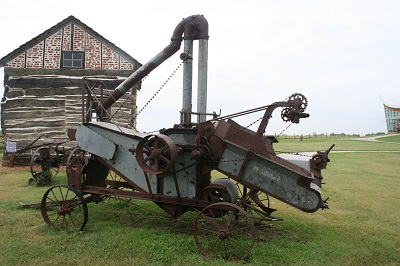Last updated: January 13, 2024
Lesson Plan
Agriculture and Inventions

- Grade Level:
- Middle School: Sixth Grade through Eighth Grade
- Subject:
- Social Studies
- Lesson Duration:
- 90 Minutes
- Common Core Standards:
- 6-8.RH.4, 6-8.RH.5, 6-8.RH.6, 6-8.RH.7, 6-8.RST.6, 6-8.RST.7, 6-8.RST.8, 6-8.RST.9
- Thinking Skills:
- Understanding: Understand the main idea of material heard, viewed, or read. Interpret or summarize the ideas in own words. Applying: Apply an abstract idea in a concrete situation to solve a problem or relate it to a prior experience. Analyzing: Break down a concept or idea into parts and show the relationships among the parts.
Essential Question
What technologies make our lives easier? Why were they invented?
Objective
Students will:
* Cite specific textual evidence to support analysis of science and technical texts.
* Determine the central ideas or conclusions of a text; provide an accurate summary of the text distinct from prior knowledge or opinions.
* Determine the meaning of symbols, key terms, and other domain-specific words and phrases as they are used in a specific scientific or technical context relevant to grades 6-8 texts and topics.
Background
For homesteaders, life on the Plains was rough and hard. Everyone had to pitch in to help the family survive. The men plowed, planted, and harvested the crops. They took the grain to the nearest mill, which could take several days of traveling.
The women took care of the house and the garden. They often sold butter and eggs to supplement the family income. This money paid for the extras the family could not otherwise afford. Children helped out wherever they were needed. They might gather buffalo or cow chips for fuel, herd the animals, help in the fields, or any other task that needed to be done.
Helping out one's neighbor was common place on the plains. Settlers held gatherings or bees. Neighbors might help plow a field, build a barn or house, or husk the corn. These bees were opportunities for homesteaders to help each other and socialize at the same time.
Hardships abounded on the prairie. Homesteaders faced many difficulties while living on the Great Plains. Isolation and loneliness created some of the most difficult moments especially for women who seldom left their homesteads.
The climate of the plains was harsh to homesteaders. One year a homesteader might face a drought while the next year a flood might ruin every hope of an abundant crop. Prairie fires and grasshopper invasions were also constant threats.
Many homesteaders could not handle the overwhelming obstacles in their path. Those who came to homestead with the lure of cheap lands left, "busted and disgusted" at the hard life on the prairie. In several areas almost half the homesteaders left. Others stayed to "tough it out."
At one time or another many homesteaders had to face making the decision to stay on their homestead or head back east. There is no doubt that life was hard. For many the cost of staying was too high.
Preparation
Decide whether you will want students to work in groups or individually.
Lesson Hook/Preview
What technologies make our lives easier? Why were they invented?
In "Agriculture and Inventions," students research agricultural inventions and describe their impact on agriculture.
Procedure
Ask students what technologies make their lives easier. Why was each invented?
Write the following quote on the board. Have students explain the meaning.
"Wherever a farm may be located, or whatever may be its production, fence, fence, and fence is the first, the intermediate, and the last consideration in the whole routine of the operations of the farm." — S. Edwards Todd, The Young Farmer's Manual, 1860
How did the invention of barbed wire alter farming on homesteads?
Assessment Materials
Agriculture and Inventions AssessmentIn "Agriculture and Inventions," students research agricultural inventions and describe their impact on agriculture.
Have students make a list of inventions that played a role in the development of homesteads, for example: plow, reaper, tractor, windmill, etc.
Have students, individually or in groups, select one invention. They must research the invention and its impact on agriculture. Using the websites listed below as a starting point, students should develop multimedia presentations for the class that explain the invention, its development and its impact.
A History of American Agriculture 1776-1990
http:inventors.about.com/library/inventors/blfarm1.htm
The Iowa Agriculturist
http://www.campsilos.org/mod2/teachers/r1.shtml
A History of American Agriculture 1880
http://www.agclassroom.org/gan/timeline/1880.htm
Farming in the 1940’s
http://www.livinghistoryfarm.org/farminginthe40s/water_01.html
Farming in the 1920’s
http://www.livinghistoryfarm.org/farminginthe20s/machines_01.htm
